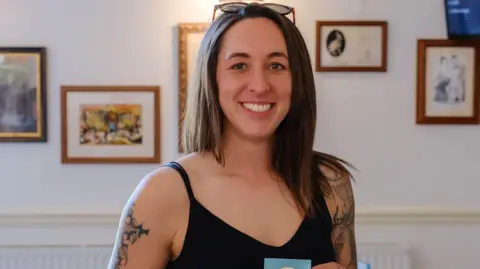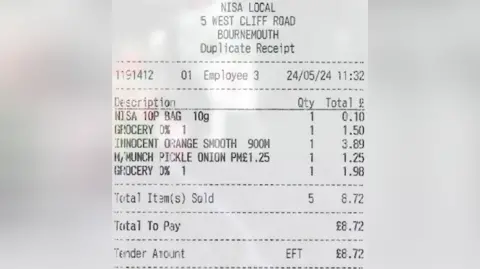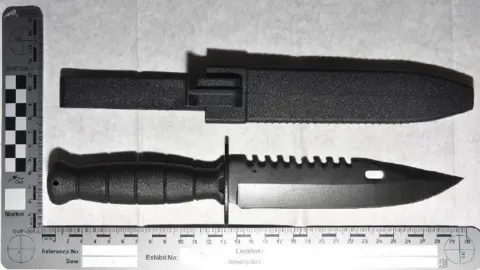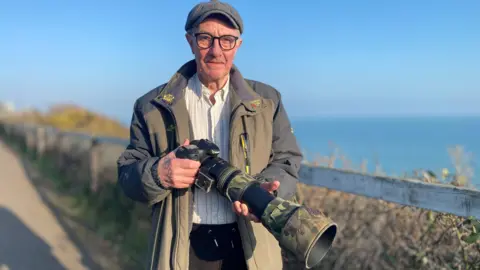How police caught killer criminology student without DNA evidence
 Dorset Police
Dorset PoliceCriminology student Nasen Saadi has been jailed for life with a minimum of 39 years for the murder of Amie Gray and the attempted murder of Leanne Miles on a Dorset beach.
The BBC explores how police put him behind bars despite having no DNA evidence.
It was a Friday night and the beach in Bournemouth was illuminated by a Blood Moon.
Amateur photographer Mick Priddle was standing on a cliff marvelling at the sky when he heard two loud screams from the sand below.
He was about to become the key witness in a murder investigation.
 Craig Blake
Craig BlakeIt would prove to be the most challenging case Det Insp Mark Jenkins had ever been in charge of.
Just before midnight on 24 May 2024, friends Amie Gray and Leanne Miles had lit a fire and were chatting on Durley Chine Beach.
After lurking on the promenade, a hooded man stepped on to the sand, repeatedly stabbed them and fled into the darkness, leaving the women to bleed to death.
Ms Miles, 38, managed to call 999 and was rushed to hospital with 20 knife wounds, mainly to her back.
But 34-year-old Ms Gray, who had been stabbed 10 times, died on the sand from a wound to her heart.
Det Insp Jenkins, of Dorset Police's major crime investigation team, said Ms Miles had given a good description of the stranger who had attacked them.
But proving who did it was going to be difficult.
He had left no forensic evidence behind.
While crime scene investigators were meticulously searching the area for fingerprints and DNA - and coming up dry - officers were reviewing the promenade's CCTV.
A camera had recorded the brutal attack.
The man was seen sprinting away towards Bournemouth pier and the zig-zag - a path leading up the cliff to West Hill Garden where there were no cameras.

"That's what I'd refer to as a pinch-point," said Det Insp Jenkins: "I knew there was only one way from that point up the cliff."
The footage was distant and grainy, he said, but it was enough to identify some distinctive clothing.
"There was a grey stripe across his jacket, which was black, he had what's been described as a bumbag with a reflective logo, and there was a strap that was hanging down on his left-hand side."
It took three days for police to identify their suspect.
'Eureka moment'
Det Sgt Sarah Gedge was part of the police team tasked with combing through thousands of hours of CCTV footage.
The breakthrough came when they spotted the suspect in daylight, on the morning of the murder, on West Hill Road.
"That was our eureka moment," Det Sgt Gedge said.
Using footage from nearby cameras they followed his movements into a convenience store.
He used his own bank card to pay for his shopping, making it easy for police to find out his name and address.
 Dorset Police
Dorset PoliceThe suspect, then 20-year-old Nasen Saadi, was traced to his aunt's house in Croydon where he was arrested on 28 May.
Police discovered he had travelled to Bournemouth on 21 May to stay at the Travelodge hotel, before carrying out several checks of the area.
He moved to the Silver How Hotel, which was slightly closer to the crime scene, the night before the attack.
In a police interview, Saadi said he had been visiting the seaside town on a solo trip, but denied being the man in the CCTV footage.
Detectives asked him what he had done after checking out of the Travelodge.
Saadi responded: "I can't remember, maybe sleepwalking… I probably blacked out," and said his next memory was being at home in Croydon on 25 May.
A deeper look into Saadi's background all but confirmed the force's suspicions.
His internet history revealed searches for "How sharp are kitchen knives", "Why is it harder for a criminal to be caught if he does it in another town" and "What hotels don't have CCTV in UK".
Just days before the murder, he had looked up "Bournemouth CCTV" and "Bournemouth pier CCTV".
Several purchases of knives had also been made online, and officers found knives, latex gloves and a balaclava at his home in Purley.
But police were only able to access "limited information" from his phone because he refused to give them his password, an offence he later pleaded guilty to.
And still they found no weapon or clothing from the night of the killing.
'Get away with murder'
Investigators discovered Saadi had an interest in true crime and was studying criminology and criminal psychology at the University of Greenwich.
He had asked lecturer Dr Lisa-Maria Reiss about pleading self-defence to murder and DNA evidence during a seminar which had not covered these topics.
She replied: "You're not planning a murder, are you?"
Dr Reiss' partner, special officer Pavandeep Singh Aneja, was asked to give a talk to students on policing the previous November.
He said Saadi had also asked questions "on DNA, how to get away with murder, these types of things".
 Dorset Police
Dorset PoliceDespite building up a detailed picture of Saadi's background, and his movements in Bournemouth, police still had no DNA evidence or a murder weapon to link him to the attack.
"I would have expected there to have been blood on his clothes but we never recovered the jacket, the bumbag, the gloves he was wearing, the knife and the footwear," Det Insp Jenkins recalled.
"We really did try very, very, hard and left no stone unturned - literally."
They needed a witness who could place Saadi at the scene of the murder.

Mick Priddle, who was used to hearing noise and excitement coming from the beach, had not realised the screams he heard that evening were of fear.
Days later, the 79-year-old photographer was flicking through a local newspaper when he saw a police appeal, featuring CCTV images of the murder suspect.
His said his mind immediately went to that night at West Cliff Garden, and that he was "100% sure" that Saadi had walked right past him.
"I said to myself immediately: 'That's him'," he told the BBC.
'Looked evil'
As he made his way home from the clifftop in Bournemouth, Mr Priddle said he saw a man appearing from steps leading up from the beach.
He described him as "menacing", wearing a coat with a distinctive marking across the chest.
"He did turn around and as he did so he was under the street lamp and the hood moved and I got a very good view of his face."
Mr Priddle was able to identify Saadi as the man he saw from a selection of photographs given to him by police, and later gave evidence in court.
"He just looked evil," he said.
Det Insp Jenkins said he played an important part in securing the conviction against Saadi.
"I am thankful in some respects that my hobby bought me to the cliff," Mr Priddle added.
Saadi was charged with the murder of Ms Gray and the attempted murder of Ms Miles a week after the attack.
He denied the charges but chose not to give evidence during the nine-day trial at Winchester Crown Court.
The jury found him guilty of both counts and he has since begun his life sentence behind bars.

It was a successful outcome for Dorset Police, who had worked around the clock to track Saadi down.
Det Insp Jenkins told the BBC he was hugely proud of his 150-strong team.
He described Ms Gray's injuries as catastrophic, adding Saadi had "clearly been determined".
'No answers'
"They were doing nothing wrong, Amie and Leanne were sitting on the beach enjoying a May evening in front of a fire, talking quietly with nobody around.
"And I think that's possibly why they were selected by him," he said.
"We've never really been able to hear from him as to what his motive was.
"It makes it hard to explain to Amie's family and to Leanne why this happened because I don't have any answers."
You can follow BBC Dorset on Facebook, X (Twitter), or Instagram.
